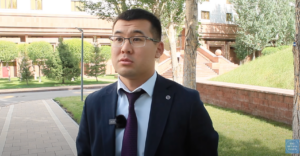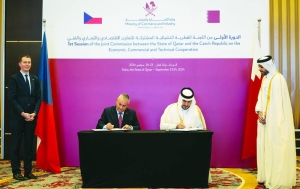Kazakhstan to Adopt New Water Code in 2024

ASTANA – Kazakhstan is expected to adopt the Water Code by the end of 2024. The document is now being considered by Mazhilis, a lower chamber of the Kazakh Parliament, said Serikzhan Beketaev, director of the Water Policy Department at the Kazakh Ministry of Water Resources and Irrigation, in a recent interview with The Astana Times.

The Kurchum bridge crossing over the Bukhtarma reservoir in the East Kazakhstan Region. Photo credit: primeminister.kz
The document was submitted to the Parliament in January. It is expected to become an important instrument, envisaging measures for efficient water use, introducing water-saving technologies, and helping to predict, plan, and respond to extreme events such as floods and droughts.
President Kassym-Jomart Tokayev directed the government to rewrite the Water Code in February 2022. The previous strategic document, dated 2003, no longer met the emerging trends affecting water issues.

Serikzhan Beketaev. Photo credit: The Astana Times
Kazakhstan’s new water legislation aims to develop integrated management of the nation’s water resources, emphasizing management and protection based on the basin principle. Public involvement in addressing water conservation and usage issues is a key objective, alongside establishing a comprehensive national policy for water saving.
The document identifies water security as an integral part of national security. It also defines the legal status of water-related entities and clarifies the rights and responsibilities of stakeholders in the conservation and use of water resources.
Additionally, it specifies the duties of those managing and developing water infrastructure while promoting the application of scientific approaches to state water management, including planning, monitoring, and regulation. The legislation seeks to regulate water-related activities and ensure enforcement through state and public oversight, strengthening the legal framework for water protection and use.
“Our ministry, the whole government, and the President are paying significant attention to the issue of water security and sustainable development in the water sector. The most important document for us is the Water Code, which has been revised, including in terms of global climate change,” Beketaev recently told The Astana Times.
The working group was set up in the Mazhilis and has been working on the draft of the new code since March.
“It also provides for separate blocks in our water code regarding the need to adapt to climate change and glacier conservation. In general, the issue should be addressed comprehensively,” said Beketaev.
Key directions
The ministry outlined three key areas in terms of how it seeks to transform the water sector in Kazakhstan. The first one is the development of a fundamentally new legal and regulatory framework. The second direction includes full-scale modernization of water infrastructure, the introduction of advanced water-saving technologies, and digitalization of water metering and distribution, as well as the introduction of a new tariff policy and the development of a culture of water-saving in the country.
Strengthening transboundary cooperation with neighboring states is a third priority. Since the beginning of 2024, the ministry has participated in at least 15 events with representatives of neighboring states to discuss transboundary water management.
Strategic documents
Besides the Water Code, the ministry also developed a concept for the development of water management systems for 2024-2030. The document was adopted by the government in February.
According to Beketaev, the concept offers comprehensive approaches to modernizing the water management system, rational use, improvement of institutional and personnel support, and transboundary cooperation.
It outlines measures to build 20 new reservoirs, reconstruct 15 reservoirs, and modernize more than 14,000 kilometers of irrigation canals and hydraulic structures. Overall, key targets include increasing the area of irrigated agricultural land to 2.5 million hectares and reducing irrigation water loss during transportation to 25%.
Another document, a roadmap for water saving for 2024-2026, entails measures to digitalize the water sector, improve state support measures for farmers, introduce modern water-saving technologies, and transition to more cost-effective crops.
Intensifying impact of climate change
Beketaev noted that climate change is on the global agenda, and its impact has intensified in recent years.
According to Kazhydromet service, in 2021, the average annual air temperature in Kazakhstan was 1.58 degrees Celcius above the climatic norm for the 1961-1990 period. An analysis of trends in surface air temperature extremes and precipitation from 1961 to 2021 reveals a widespread increase in the number of heatwaves during the warm season. The total and maximum duration of heatwaves has also risen, along with the duration of heat waves throughout the year.
“The territory of Kazakhstan is vast. Hence there are several continental divisions. In the northern regions, we have plains, where spring floods are mainly formed. This year, there was very serious damage from floods. In the southern regions, on the contrary, we have a water deficit because of intensive water consumption. As a whole, we have about 100 cubic kilometers of water resources in the country, of which about 50% are formed at the expense of local runoff and 50% at the expense of transboundary runoff,” he explained.
Mountain glaciers and snowfields in the Pamir and Tien Shan mountains are key freshwater sources, feeding major rivers during the melt seasons. Climate change is causing these glaciers to retreat, reducing meltwater flow.
“For example, as of 2018, about 45 cubic meters of water were formed by glaciers. They are also intensively melting. According to the forecasts of the Institute of Geography, up to 2030, we will have a possible increase in local runoff due to the intensive melting of glaciers. That said, this runoff will decrease as the formation of these glaciers each year will be unsustainable. It will not keep up due to climate change,” said Beketaev.
Agriculture
Globally, agriculture is the main consumer of water resources.
“Currently, irrigation accounts for about 60% of Kazakhstan’s total water usage. This 60% translates to roughly 14 cubic kilometers of water across the country. The majority of this water is used in the southern regions,” said Beketaev.
However, almost half of the water does not reach the fields because of outdated and inefficient water infrastructure. Most of it was built 50 or 60 years ago and hardly meets modern requirements.
According to official data, climate change also affects crop water consumption standards. For regular irrigation, water consumption rates increased from 8.5 cubic meters per hectare to 10 cubic meters per hectare between 2011 and 2022.
To promote the rational use of water, efforts are being made in the fields to encourage farmers to adopt water-saving technologies.
The ministry recently announced it would increase subsidies for farmers who introduce water-saving technologies by 30%. Subsidies for the purchase and installation of water-saving systems will rise from the current 50% to 80%.
“According to research conducted by the Kazakh Scientific Research Institute of Water Economy, if these water-saving technologies cover at least 50% of the irrigated lands in Kazakhstan, we can save approximately 2.4 cubic kilometers of water,” said Beketaev.
Meanwhile, in the southern regions of the country, which are responsible for the majority of irrigated agriculture, water-saving technologies are implemented on only 3% of the total irrigated land area.
The latest episode on The Astana Times’ YouTube channel discusses water issues across Central Asia.





